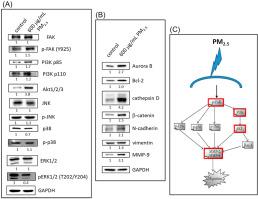Chemosphere ( IF 8.1 ) Pub Date : 2020-11-20 , DOI: 10.1016/j.chemosphere.2020.129028 Chun-Wen Cheng , Gwo-Tarng Sheu , Jing-Shiuan Chou , Pei-Han Wang , Yu-Chun Cheng , Chane-Yu Lai

|
Objectives
This study investigates the effects of water-extracted PM2.5 on a triple-negative breast cancer (TNBC) cell line, MDA-MB-231, by sampling suspended particulates around a building demolition site.
Methods
PM2.5 particles were obtained using a high-flow TISCH sampler. Water-soluble PM2.5 were extracted by an ultrasonic oscillator and then freeze-dried. The heavy metal components of soluble PM2.5 was analyzed by ICP-MS. Cell viability was evaluated by MTT assay for cells that were exposed to PM2.5 (200, 400 and 600 μg/mL). Wound healing and transwell cell migration and invasion assays were used to measure cell motility and the invasiveness of cancer cells that had been exposed to PM2.5 into a chemo-attractant substance. Interrelated mechanisms of cancer malignancy were analyzed by Western blot analysis.
Results
Nearby PM2.5 concentrations increased significantly during the deconstruction of buildings, and the Cd, Cu, Pb, Zn and Cr contents of soluble PM2.5 also significantly increased. Following exposure to PM2.5, the survival rate of breast cancer cells was significantly higher than that of the control group. Soluble PM2.5-treated cells had a higher migration capacity. The signaling pathway of FAK/PI3K/AKT proteins was more activated in PM2.5-treated cells than the control group. Increased levels of Aurora B and Bcl-2 were associated with cell proliferation. Elevated levels of cathepsins D, β-catenin, N-cadherin, vimentin and MMP-9 were associated with breast cancer cell metastasis.
Conclusion
Soluble PM2.5 from building demolition may promote/progress in surviving TNBC cells, increasing the malignancy of breast cancer. This study offered evidence of a link between demolition PM2.5 and cancer progression.
中文翻译:

建筑物拆除产生的细颗粒物PM 2.5会增加乳腺癌MDA-MB-231细胞的恶性程度
目标
这项研究通过对建筑物拆除现场周围的悬浮颗粒进行采样,研究了水提取的PM 2.5对三阴性乳腺癌(TNBC)细胞系MDA-MB-231的影响。
方法
使用高流量TISCH采样器获得PM 2.5颗粒。用超声波振荡器提取水溶性PM 2.5,然后冷冻干燥。可溶性PM 2.5的重金属成分通过ICP-MS分析。通过MTT分析评估暴露于PM 2.5(200、400和600μg/ mL)的细胞的细胞活力。伤口愈合,transwell细胞迁移和侵袭试验用于测量细胞运动性以及已暴露于PM 2.5的癌细胞对化学吸引剂的侵袭性。通过Western blot分析癌症恶性肿瘤的相关机制。
结果
建筑物解构期间附近的PM 2.5浓度显着增加,可溶性PM 2.5的Cd,Cu,Pb,Zn和Cr含量也显着增加。暴露于PM 2.5后,乳腺癌细胞的存活率显着高于对照组。可溶性PM 2.5处理的细胞具有更高的迁移能力。与对照组相比,PM 2.5处理的细胞中FAK / PI3K / AKT蛋白的信号传导途径被激活更多。Aurora B和Bcl-2水平升高与细胞增殖有关。组织蛋白酶D,β-catenin,N-cadherin,波形蛋白和MMP-9水平升高与乳腺癌细胞转移有关。
结论
建筑物拆除产生的可溶PM 2.5可能会促进幸存的TNBC细胞的发展/进展,从而增加乳腺癌的恶性程度。这项研究提供了拆卸PM 2.5与癌症进展之间联系的证据。











































 京公网安备 11010802027423号
京公网安备 11010802027423号